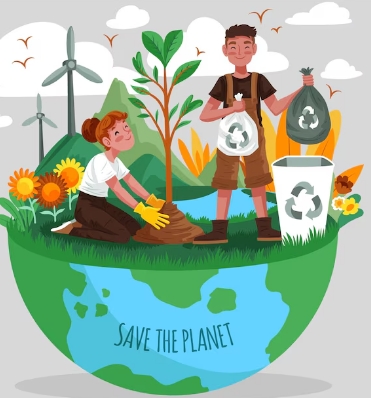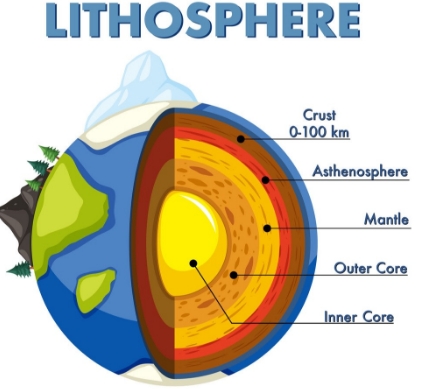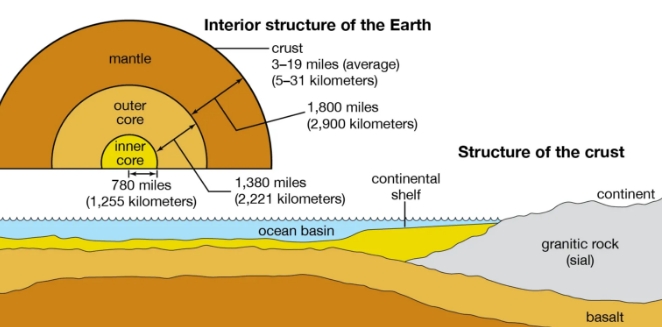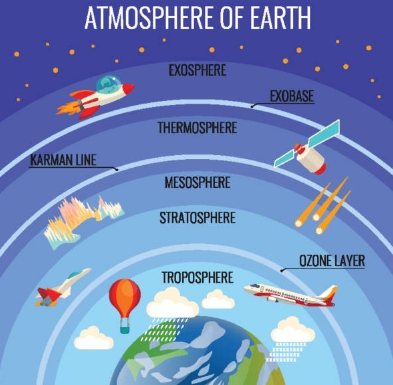
CBSE Class 7 Geography Notes Chapter 1: Everything surrounding us is our environment. Physical, chemical, and other natural forces are included, as well as life or non-living entities. Natural equilibrium is preserved through the interplay between biotic and abiotic elements. The natural environment and the human environment are the two main categories of the environment.
Environment (Chapter 1) of CBSE Class 7 Geography covers the natural and human environments as well as ecosystems. To help students quickly review the entire chapter before the exam, all of these concepts are included in the CBSE Class 7 Geography notes of Chapter 1.CBSE Class 7 Geography Notes Chapter 1 Overview
The location, people, objects, and natural surroundings of any living entity are referred to as the environment. It is a hybrid of man-made and natural events. The term "natural environment" refers to both biotic and abiotic elements that exist on Earth, whereas the term "human environment" refers to human creations, activities, and interactions.CBSE Class 7 Geography Notes Chapter 1 PDF
Here we have provided CBSE Class 7 Geography Notes Chapter 1 for the ease of students so that they can just download the pdf and use it easily without the internet. These CBSE Class 7 Geography Notes Chapter 1 will help students understand the chapter better.CBSE Class 7 Geography Notes Chapter 1 PDF
CBSE Class 7 Geography Notes Chapter 1
Environment The word "environment" comes from the French word "environner," which means "neighbourhood." An environment is anything that envelops a living creature. The location, people, nature, and objects that surround any particular living being can all be considered parts of the environment. All living things share an environment that is created by the combination of natural and man-made resources. Earth's natural ecosystem is made up of both biotic and abiotic components. However, man-made occurrences like wars, global warming, and technological growth will expose every human interaction and creation. Habitat is often formed by all of the inventions created by nature and humans. Human needs have increased, which has increased human contact with the environment. Among the many things that humans have learnt are how to correctly cultivate crops and tame animals. The emergence of innovations and technology also contributed to a rise in output. It also made transit considerably faster and easier. The information revolution also ushered in a whole different human environment. Natural: Air (atmosphere), Water (hydrosphere), Land (lithosphere), and Living Things (biosphere) are the components of the environment. Interactions between people on an individual, family, societal, religious, political and economic level.
Parks, buildings, bridges, roads, industries, and monuments are all man-made.
Natural: Air (atmosphere), Water (hydrosphere), Land (lithosphere), and Living Things (biosphere) are the components of the environment. Interactions between people on an individual, family, societal, religious, political and economic level.
Parks, buildings, bridges, roads, industries, and monuments are all man-made.
-
Biotic Components: All the living organisms in our environment are said to be biotic components. Example: Plants and animals.
-
Abiotic Components: All the non-living organisms in the environment form the abiotic components. Example: Land and mountain.
Components of Environment
Learn about the various elements that make up the environment, such as the air, water, land, and living things. Recognise the need to conserve these elements and the effects that human activity has on them.Natural Environment
A natural environment is all that surrounds any living thing that was not created by humans. The natural environment is made up of both biotic (living things) and abiotic (non-living things). The natural environment is made up of plants, animals, water, and air. The earth's hard top layer, or lithospheric crust, is known as the lithosphere. It is composed of minerals and rocks, with a thin coating of dirt covering it. It is an uneven surface that is home to a variety of landforms, including plains, valleys, mountains, and plateaus. The realm of the lithosphere is where human settlements, agriculture, grazing areas, and forests are found. It provides wealth in minerals as well. The hydrosphere is the name given to the domain of water. It includes diverse kinds of water bodies such as lakes, rivers, seas, and oceans, as well as varied sources of water. It is necessary for all living things. The thin layer of air that envelops the planet is known as the atmosphere. The atmosphere is held in place by the Earth's gravitational pull. It shields us from the sun's damaging rays and intense heat. It is made up of water vapour, dust, and other gases. The weather and climate are affected by changes in the atmosphere. The biosphere, or living world, is made up of the kingdoms of plants and animals. It is a little area of the planet where air, water, and land combine to support life. The natural environment is classified into various domains: Lithosphere Hydrosphere Atmosphere Biosphere Lithosphere It is the earth's hard top layer or solid crust.
It is composed of minerals and rocks, with a thin layer of dirt covering it.
The surface is uneven and features a variety of landforms, including plains, valleys, mountains, and plateaus.
This domain gives us access to human settlements, agriculture, grazing areas, and woods.
It provides wealth in minerals as well.
Hydrosphere
It is the earth's hard top layer or solid crust.
It is composed of minerals and rocks, with a thin layer of dirt covering it.
The surface is uneven and features a variety of landforms, including plains, valleys, mountains, and plateaus.
This domain gives us access to human settlements, agriculture, grazing areas, and woods.
It provides wealth in minerals as well.
Hydrosphere
 The hydrosphere is the domain of water.
It includes diverse kinds of water bodies such as lakes, rivers, seas, and oceans, as well as varied sources of water.
It is necessary for every living thing.
Atmosphere
The hydrosphere is the domain of water.
It includes diverse kinds of water bodies such as lakes, rivers, seas, and oceans, as well as varied sources of water.
It is necessary for every living thing.
Atmosphere
 The thin layer of air that envelops the planet is known as the atmosphere.
It is made up of water vapour, dust, and other gases.
Weather and climate change as a result of atmospheric changes.
The atmosphere is held in place by the Earth's gravitational pull.
It shields us from the sun's damaging rays and intense heat.
Biosphere
The term "Biosphere" refers to the living realm. The biosphere is made up of the kingdoms of plants and animals.
It is a small area of the planet where air, water, and land combine to support life.
The thin layer of air that envelops the planet is known as the atmosphere.
It is made up of water vapour, dust, and other gases.
Weather and climate change as a result of atmospheric changes.
The atmosphere is held in place by the Earth's gravitational pull.
It shields us from the sun's damaging rays and intense heat.
Biosphere
The term "Biosphere" refers to the living realm. The biosphere is made up of the kingdoms of plants and animals.
It is a small area of the planet where air, water, and land combine to support life.
Ecosystem
All living things interact with one another and the physical and chemical elements of their surroundings to form this system, which is connected by the exchange of material and energy. Every living thing—plants, animals, and humans included—depends on everything else. Their local environment creates an ecosystem. Large rainforests, grasslands, deserts, mountains, lakes, rivers, oceans, and even tiny ponds could all be part of the ecosystem.Environmental Laws and Initiatives
Learn about the environmental regulations and programmes that have been put in place to protect the environment. Find more about national and international organisations that promote environmental conservation.Conservation of Environment
Examine the importance of sustainable development and environmental preservation. Investigate ways to save and maintain our environment, such as afforestation, water resource conservation, and waste management.Human Environment
People engage with their surroundings and alter them to suit their needs. Human needs expanded and changed over time. Humans acquire new skills to adapt to and alter their surroundings. People engage with their surroundings and alter them to suit their needs. In the past, people adjusted to their natural environments and used the surrounding natural resources to meet their needs. The needs of people changed over time. People developed the ability to raise crops, tame animals, and live settled lives. The wheel was created, more food was produced than needed, the barter system evolved, trade began, and business flourished. Mass production was made possible by the Industrial Revolution. Transportation accelerated. Global communication is now quicker and easier because of the information revolution. They learn how to cultivate crops, tame animals, and lead settled lives. The wheel was created, food surpluses were produced, the barter system evolved, trade began, and commerce flourished. Large-scale production was made possible by the Industrial Revolution, which also sped up transportation and facilitated global communication.Benefits of CBSE Class 7 Geography Notes Chapter 1
Our revision notes for CBSE Class 7 Geography Environment Chapter 1 are designed to assist students in meeting their learning objectives since they cover the key ideas clearly and thoroughly. Our knowledgeable instructors and subject matter specialists have carefully selected the notes we offer, meeting the needs of our students for study materials that are suitable for exams and that will enable them to finish their revisions with minimal difficulty. These notes make it simple for students to review the main points of the chapter and provide further details as needed during the test.CBSE Class 7 Geography Notes Chapter 1 FAQs
What are the components of the environment Class 7 notes?
Plants, air, animals, water, and land are components of the natural environment. The various components of the environment are mentioned below: Lithosphere: The hard top layer of the earth, or the solid crust, is known as the lithosphere.
What is the first chapter of Geography class 7th?
Environment
Why is environment important class 7?
Environment plays an important role in healthy living and the existence of life on planet earth. Earth is a home for different living species and we all are dependent on the environment for food, air, water, and other needs. Therefore, it is important for every individual to save and protect our environment.
🔥 Trending Blogs
Talk to a counsellorHave doubts? Our support team will be happy to assist you!

Check out these Related Articles
Free Learning Resources
PW Books
Notes (Class 10-12)
PW Study Materials
Notes (Class 6-9)
Ncert Solutions
Govt Exams
Class 6th to 12th Online Courses
Govt Job Exams Courses
UPSC Coaching
Defence Exam Coaching
Gate Exam Coaching
Other Exams
Know about Physics Wallah
Physics Wallah is an Indian edtech platform that provides accessible & comprehensive learning experiences to students from Class 6th to postgraduate level. We also provide extensive NCERT solutions, sample paper, NEET, JEE Mains, BITSAT previous year papers & more such resources to students. Physics Wallah also caters to over 3.5 million registered students and over 78 lakh+ Youtube subscribers with 4.8 rating on its app.
We Stand Out because
We provide students with intensive courses with India’s qualified & experienced faculties & mentors. PW strives to make the learning experience comprehensive and accessible for students of all sections of society. We believe in empowering every single student who couldn't dream of a good career in engineering and medical field earlier.
Our Key Focus Areas
Physics Wallah's main focus is to make the learning experience as economical as possible for all students. With our affordable courses like Lakshya, Udaan and Arjuna and many others, we have been able to provide a platform for lakhs of aspirants. From providing Chemistry, Maths, Physics formula to giving e-books of eminent authors like RD Sharma, RS Aggarwal and Lakhmir Singh, PW focuses on every single student's need for preparation.
What Makes Us Different
Physics Wallah strives to develop a comprehensive pedagogical structure for students, where they get a state-of-the-art learning experience with study material and resources. Apart from catering students preparing for JEE Mains and NEET, PW also provides study material for each state board like Uttar Pradesh, Bihar, and others
Copyright © 2025 Physicswallah Limited All rights reserved.
Get App







